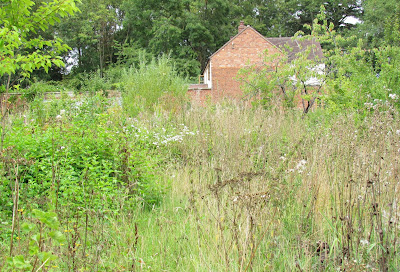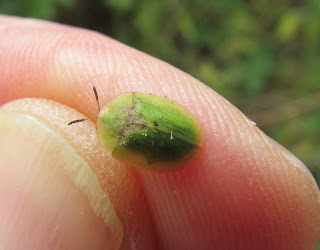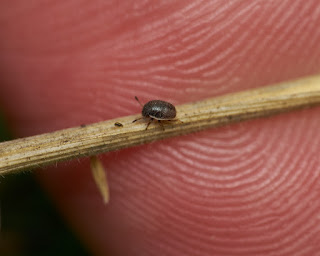This is a site that we have looked at, enviously, many times as we have passed it on our way to other sites. Getting access has been beyond us but thanks to a good friend who now works for Natural England we were given permission to visit.
The SSSI citation, available via the Natutral England Designated Sites View website summarises the site as follows:
"A small remnant of the heathland which was formerly more extensive in North Shropshire.
"The site is predominantly wet heath, but areas of dry heath and secondary woodland occur. There are also a number of ponds."
Click here to see the full citation.
Here is a view looking roughly south from a very high tripod!
 |
| Photograph: Bob Kemp |
The woodland soon gave way to a small patch of rough vegetation, which produced a reasonable number of common bugs associated with long grass, nettle, dock and similar plants.
This ended quickly and we found ourselves on the heath.
A sample of vegetation in the area of the above photograph included a Shropshire first - the barkfly Kolbia quisqiliarum. Sorry, no photograph. It was a very small bland wingless insect. Pictures can be seen on the National Barkfly Recording Scheme website (click here to view).
The same sample captured a couple of "inconspicuous" ladybirds - so called because the are small and not brightly marked like the ladybirds we are used to seeing.
Wandering on, following the track, we came across a Ruddy darter
 |
| Photograph: David Williams |
 |
| Photograph: David Williams |
 |
| Photograph: Bob Kemp |
 |
| Photograph:Bob Kemp |
Looking for invertebrates here was quite tricky as the ground was very undulating and sometimes unexpectedly very wet. But there were several tree stumps that had mental notices on them saying "Sit here and have lunch".
So we did.
Clearly one of the stumps was a regular resting spot for another Ruddy darter as it kept trying to push its occupant off. Eventually it realised that the size difference was too great to overcome and settled on the occupant's bag and tried to stare him out. This gave the perfect photo-opportunity.
 |
| Photograph: David Williams |
A sweep of the grass captured a Spike shieldbug.
 |
| Photograph: David Williams |
 |
| Photograph: David Williams |
 |
| Photograph: David Williams |
Rhododendron was abundant here occupying the space under and between the trees. A Bronze shield bug was dislodged from one bush together with its meal, a 7-spot ladybird.
 |
| Photograph: David Williams |
Rhododendron is an alien plant and steps are being taken to remove it but it does support a wonderful garishly patterned planthopper Graphocephela fennahi. I beat some of the plant and found my first. I was disappointed that I could not appreciate fully its pattern as it had seen better days.
I moaned about this to the others!
"No problem"
It is abundant here.
And when I looked more carefully I could see lots of them.
The planthopper is itself an alien being a native of the USA. So we had an alien insect on an alien plant. I suppose that is almost acceptable.
No-one thought to photograph the hopper but information about it can be found on the British Bugs website. (Click here.)
As we started back a couple of Agroeca spider egg-sacs were found suspended on twigs.
 |
| Photograph: David Williams |
 |
| Photograph: David Williams |
A little further on a female Bog bush cricket was spotted in a dry drainage ditch. Our intrepid photographer climbed in and was, eventually, rewarded.
 |
| Photograph: David Williams |
My thanks to Pete Boardman and Natural England for arranging access to this excellent site. Thanks also to the photographers David Williams and Bob Kemp for providing the images that provide the highlights of these reports.











































































